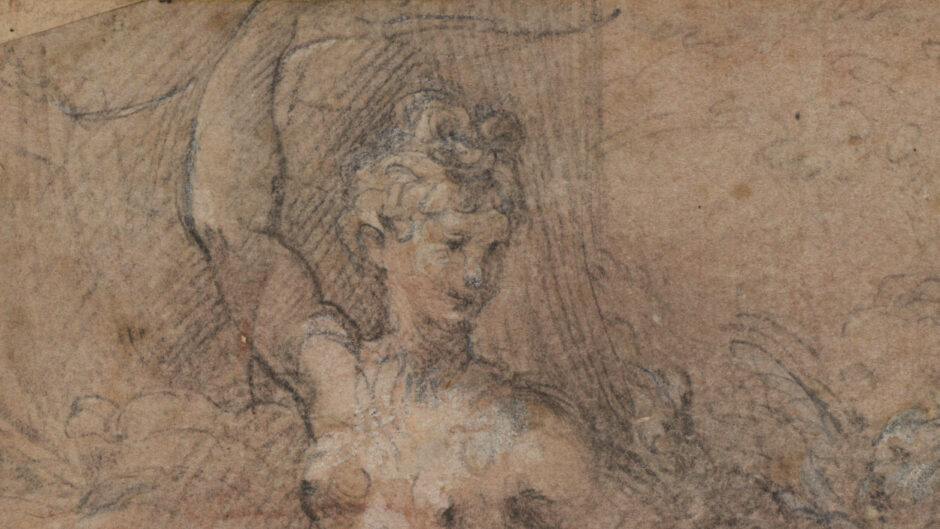The scene depicted in the drawing is taken from an episode in Ovid’s Metamorphoses in which Cupid accidently shoots his mother Venus with an arrow, causing her to fall in love with the mortal Adonis. The furious Venus disarms her son for causing her to suffer the torments of love. Parmigianino studied this composition in a number of drawings at Budapest and Parma.[1] These appear to have made in preparation for an unknown work, possibly a painting or a chiaroscuro woodcut, which he intended to realize during his stay in Bologna between 1527 and 1530, after his departure from Rome following the Sack of 1527.
Venus occupies an exceptionally large portion of the page. The artist experimented with different positions for the figure’s arms in particular, striving for a balance of dynamic movement. The drawing is finished with a pale pink wash, creating a subtle tonal gradation, and white chalk has been used to highlight the movements of Venus. The layering of media applied to the surface creates a complex pictorial effect. The paper is used as a mid-tone to accentuate the dark and light effects of the black and white chalk.
Contemporaries of Parmigianino often commented on the grazia, or grace, of his works, which, according to Ludovico Dolce (Dialoghi, 1557), consisted in “a certain loveliness which makes whoever looks at them fall in love with them”.[2]
Grace was one of the key aesthetic qualities that defined the highest achievements of modern art for Vasari and this quality made many think that the spirit of Raphael, who died in 1520, revived in Parmigianino. Like Raphael, Parmigianino was a prolific and exceptionally gifted draughtsman and the Courtauld drawing testifies to his particular skill in depicting female beauty. Typically characterized by elegantly elongated forms, Parmigianino’s depictions of women have been associated by Elizabeth Cropper with ideas about an idealized canon of beauty expressed by writers such as the Florentine Agnolo Firenzuola, who lived in Rome at the court of Pope Clement VII (reigned 1523-1534) in the same years in which Parmigianino was there (1524-1527).[3] Parmigianino’s poetic approach to the depiction of the female body led him to blur the distinction between sacred and pagan figures, so that the Courtauld drawing effectively bears the greatest resemblance for its imposing monumentality to the figure in his later, and possibly most famous work, Madonna of the Long Neck, 1534-5 (Florence, Uffizi).
Footnotes
[1] Popham 1971, 52-53, cat. 30.
[2] Cited from Correggio and Parmigianino 2000, 18.
[3] Cropper 1976, 376.
Bibliography
Correggio and Parmigianino 2000
Correggio and Parmigianino: Master Draughtsmen of the Renaissance, eds. C. Bambach, H. Chapman, M. Clayton and G.R. Goldner, exh. cat., London 2000.
CROPPER 1976
Elizabeth Cropper, “On Beautiful Women, Parmigianino, Petrarchismo, and the Vernacular Style”, Art Bulletin, vol. 58 no. 3, 1976, pp.374-394.
POPHAM, 1971
Arthur E. Popham, The Drawings of Parmigianino, New York, 1971.







